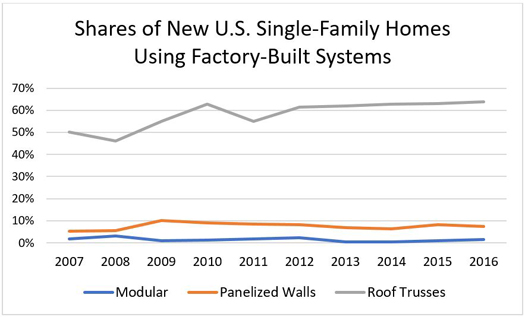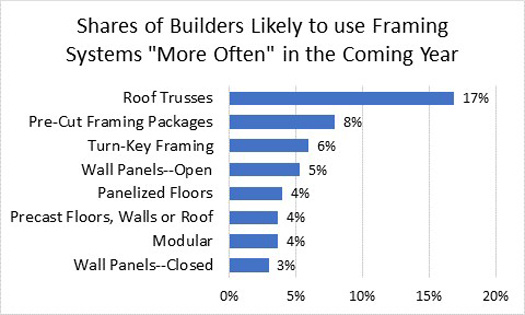May 3, 2018
Labor Shortage Leads to Growth Opportunities in Skills-Reducing, Efficiency-Improving Technologies
The “skill” in the construction industry’s Skilled Labor Shortage is driving market change, favoring skills-reducing and efficiency-improving innovations. More and more, this is not just a matter of simply moving the work from the jobsite to the factory. Rather, many opportunities for manufacturers seem to lie in creating technologies that can maximize efficiencies for both skilled and unskilled laborers on site, while not eliminating either role.
Labor-saving innovations have always been part of construction, but there are different means of gaining efficiency. Some new building products and materials, such as pre-assembled components, are created to move work that’s typically done at the jobsite into the factory. Other innovations reduce the skill level required to install a product or system, allowing contractors to populate crews with fewer highly-experienced workers. Some others make installation easier, which allows the same crew to do more work in a given day. Some innovations do all the above! This begs the question, which of the three strategies to increase construction efficiency will be favored as the new home market rebounds and the skilled construction labor shortage continues?
Home Innovation Research Labs has been tracking the use of labor-saving construction methods for decades, such as roof trusses, wall panelization, and modular construction. Other examples of components that were site-built many years ago but have moved to the factory or shop are pre-hung doors, pre-hung windows, and cabinets. Most of these improvements, involve moving the craftsman from the site to the shop OR eliminating the need for craftsmen through machinery and automation. These types of products allow builders to maintain control of ultimate installation at the jobsite yet reduce the skill level required and eliminate inefficiencies using their existing labor force.
The chart below is a history of Home Innovation’s survey findings of single-family home builders and their use of three labor reducing technologies – modular, panelized walls, and roof trusses.

Source: Home Innovation's Annual Builder Practices Survey
In our most recent Omnibus Survey of builders, fielded earlier this spring, we asked which labor-saving technologies builders are more likely to use in the coming year. A summary of findings is show in the graph below.

Source: Home Innovation’s April 2018 Omnibus Survey of Home Builders
The two technologies builders plan to use more frequently are roof trusses and pre-cut framing packages. Trusses are pre-assembled, eliminating the need to measure and cut rafters and ceiling joists, a skill that is quickly vanishing from today’s framing crews, especially for the complex roof lines in present day homes. Pre-cut framing packages are sent to the jobsite, in bundles and numbered, also eliminating most measuring and cutting at the jobsite. With both of these options, contractors still need a framing crew but are able to get by with fewer high-skilled carpenters.
For the remaining technologies, an analysis by builder subcategory and geographic area shows some bright spots for each technology.
- Northeast builders are most likely to increase use of modular systems
- West builders were most likely to increase use of turnkey framing solutions
- Builders of semi-custom homes are most likely to increase their use of wall panels
- 37% of Regional and National builders intend to use trusses more often; 23% intend to use pre-cut framing packages more often
This analysis shows most builders are not yet ready to give up their current site-built method of framing. But they are looking for ways to stretch their small pools of skilled laborers by adopting materials and techniques that require fewer skilled carpenters at the jobsite and help their current crews get work done more quickly. While continuing their search for skilled workers, contractors will necessarily end up hiring lesser-skilled workers to keep up with the pace of construction. For this reason, products that are simple and easy to install respond to the current need of most builders and will be favored over advances that simply move tasks from the jobsite to the shop or factory.
In June, we will publish our 2018 Builder Practices Reports on structural systems materials usage in new homes. Contact Ed Hudson, director of market research, to learn more about how you can get these invaluable reports to help you track, and even predict, future market direction.
Back to Top